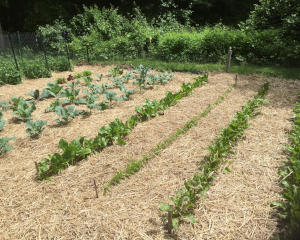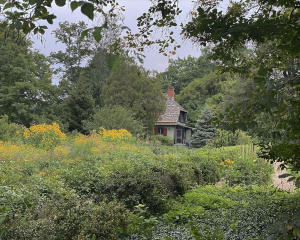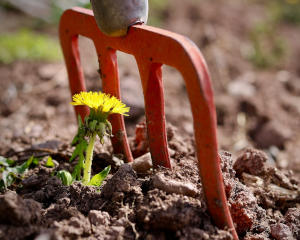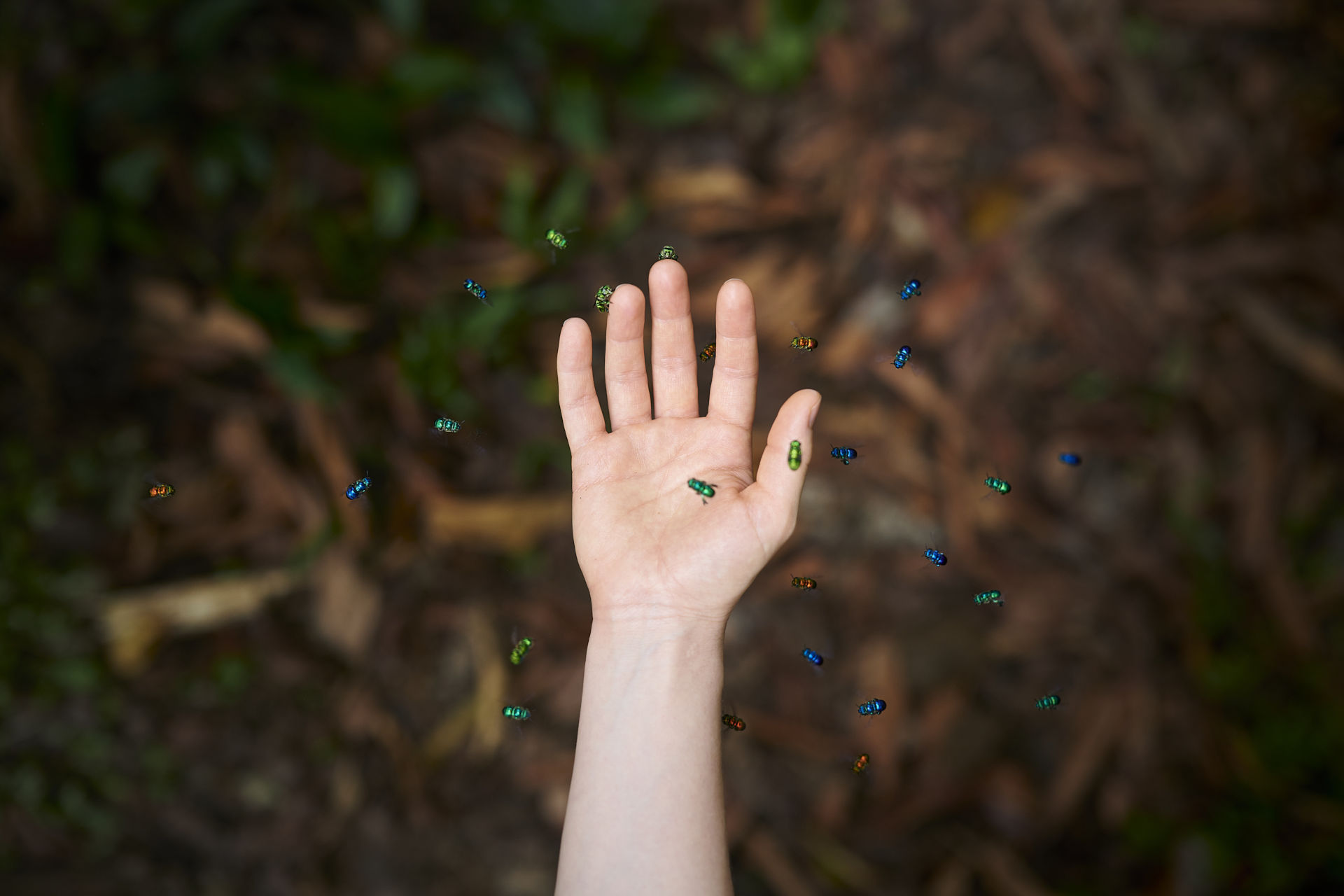
Ecological Kinship Makes Scents
Orchid Bees, Fragrance, and the Myth of the Isolated Individual
Photographs and words by Jake Eshelman,
Contributing Editor of Ecological Thinking
Sign up for our monthly newsletter!
It took several years and a global pandemic, but in January of 2022, I finally found myself in the middle of the Costa Rican rainforest surrounded by orchid bees. This, of course, was a good thing. Firstly, I had wanted to meet these cheeky, jewel-toned insects since I first discovered them through my visual research into the ethical, ecological, and emotional relationships between people and bees. Secondly—and more importantly—their presence confirmed that this specific corner of the world was teeming with fungi, fragrant plants, fallen fruit, fermenting bits, animals who poop, and so on. I know this because these are all the key ingredients of the orchid bee’s signature language: perfume.
Scent as language
Whether social or solitary in nature, bees have a distinct knack for communication. Within my cultural heritage rooted in the British Isles and Western Europe, many people maintain that bees carry messages between the living and the dead.1 There’s even a dedicated practice known as Telling the Bees, in which beekeepers inform their hive(s) of notable events in the household (e.g., births, deaths, marriages, etc.), partly to share the news with friends and family beyond the veil. It’s no wonder really, as bees have an extraordinary capacity for articulating and sharing information. In a triumph of communal wayfinding, honey bees for example perform intricate waggle dances to guide one another toward blooming plants in an ever-changing environment.2 You might also recall the term ‘hive mind’—a not-so-subtle nod to social insects—which describes the unspoken, yet seamless and synergetic cooperation between individuals of the same species. Yet beyond gesticulation and the suggestion of collective consciousness, bees are especially sensitive to chemical signals from the environment, as well as one another.
Olfactory communication is one of many things humans share with orchid bees—and we use it in much the same way. For their part, male orchid bees traverse their territories to collect scent from various sources ranging from flowering plants to rotting wood to feces.3 Each male then blends these ingredients together to create his own unique fragrance. Once it’s perfected, the bee anoints himself and uses his wings to gently fan his scent into the air as a courting ritual. In addition to the obvious messages encoded in these perfumes (e.g., “I’m here” or “Come love me”), each unique blend also communicates something vastly more meaningful, namely: “we are all ecological beings—bee, human, and otherwise.”
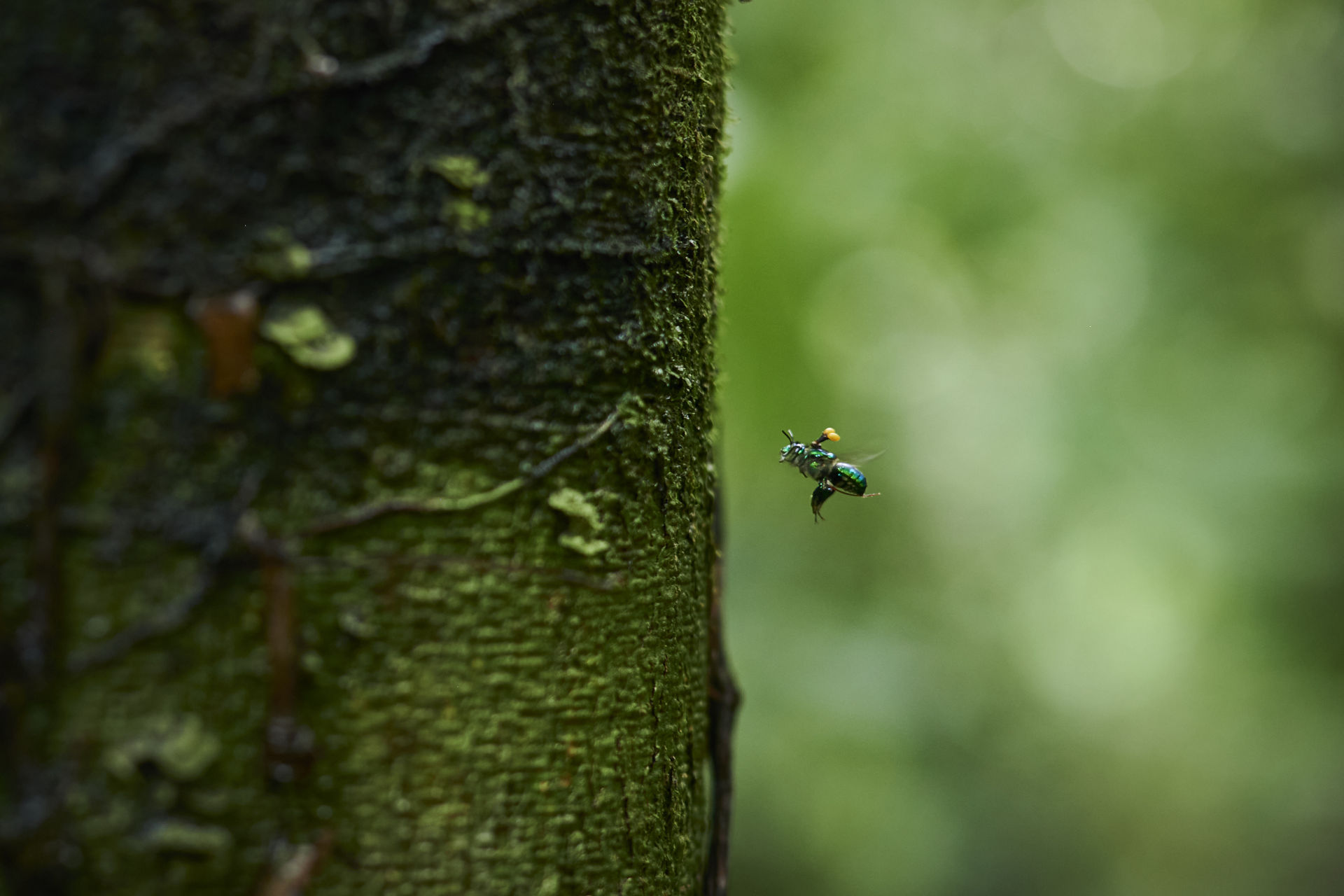
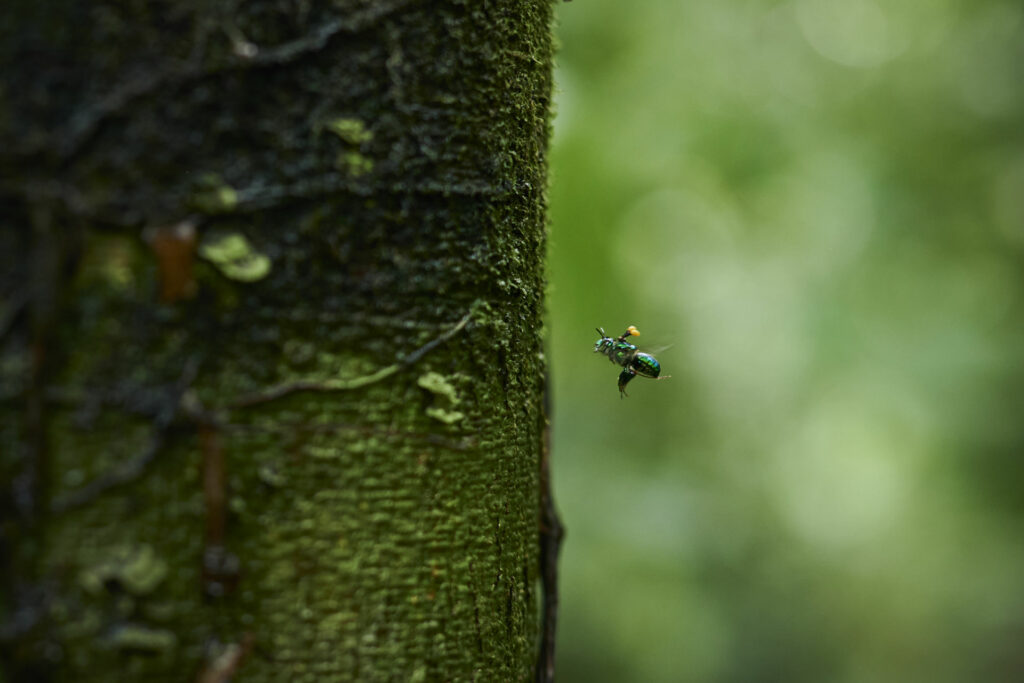
As they zip around the rainforest to create their individual fragrance, orchid bees pollinate the many plants they frequent (as illustrated above with the bee transporting the pollinia from a nearby orchid). This of course is vital in creating and maintaining the lush, biodiverse ecosystem that supports all life. Having evolved alongside endemic plant species for millions of years, solitary native bees like Euglossini (or orchid bees in biological terms) are precisely the right size, shape, and disposition to effectively
In a sense, it doesn’t take much to ‘speak’ orchid bee. To make a good first impression, I began with an earnest attempt at a congenial “hello,” which took shape as a custom fragrance made from essential oils derived from plants that orchid bees are known to enjoy. Within seconds of placing a couple drops of it onto a spot of moss in the middle of dense rainforest, orchid bees seemed to appear out of nowhere. Their astounding sensitivity to scent is hard to fathom, let alone describe. As the bees began to land on my hand and gently collect the trace amount of residual fragrance on my skin, I realized that it was ultimately plants who enabled such an intimate interspecies interaction.
The ecological underpinning of scent enables us to access a vastly more dynamic, interesting, and inclusive sense of our own (intra)personal identity.
Scent and identity
The distinct olfactory behavior I experienced of orchid bees encouraged me to think more deeply about how scent connects us all. At its very essence, fragrance fuses us to, with, and within our ecological context. For example, when we smell a flower, its scent particles physically bind to olfactory receptors in the permeable mucous membrane inside our noses. In that moment, on a molecular level, the smell of distinctive volatile organic compounds affects us with sensations—humans, plants, animals and insects.
The ecological underpinning of scent enables us to access a vastly more dynamic, interesting, and inclusive sense of our own (intra)personal identity. The olfactory epithelium is the only central nervous tissue outside the meninges that in direct contact with the environment. By providing a permeable connection to our ever-evolving surroundings, scent reminds us that we are all in a perpetual state of becoming through ecological osmosis. As our environment changes, the scents we welcome into our bodies change us too. It’s important to acknowledge that this chimerical dance extends well beyond our interactions with plants and other animals. Rather, olfaction enables us to reach beyond our haptic limitations to touch and meld with what we can’t quite grasp with our fingers: air, water, spores, sex, growth, death, decay. Put another way, scent situates and implicates us within the gushing lifeblood of ecology.
In addition to literally bonding us to other beings, scent also changes who we are in other ways. As the oldest phylogenetic sensation, smell is uniquely intertwined with our emotions.4 This is significant because chemical signals (e.g., pheromones) can trigger unconscious biological and psychological responses that directly influence our behaviors, values, and personalities—for better or worse.5 For example, while certain smells are known to induce stress, others will alleviate it. The same holds true for arousal, nostalgia, and our ability to access memory.6
When we consider how scent can manipulate our moods, bodies, and even actions, it’s fruitful to consider our relation to fragrant plants who have appealed to our aesthetic impulses through the millennia. In that respect, plants offer bees and humans a simple quid pro quo: in exchange for providing us with a positive sensory experience, we help them propagate. Some might interpret this as a sort of manipulation; a beguiling ploy on behalf of plantkind that compels us to do their bidding. We’ll call this
camp ‘survival of the fittest.’ However, I suggest that it is just as feasible—perhaps even more so—that by strengthening our ecological kinships, plant fragrance actively supports the collective flourishing of the most cooperative.
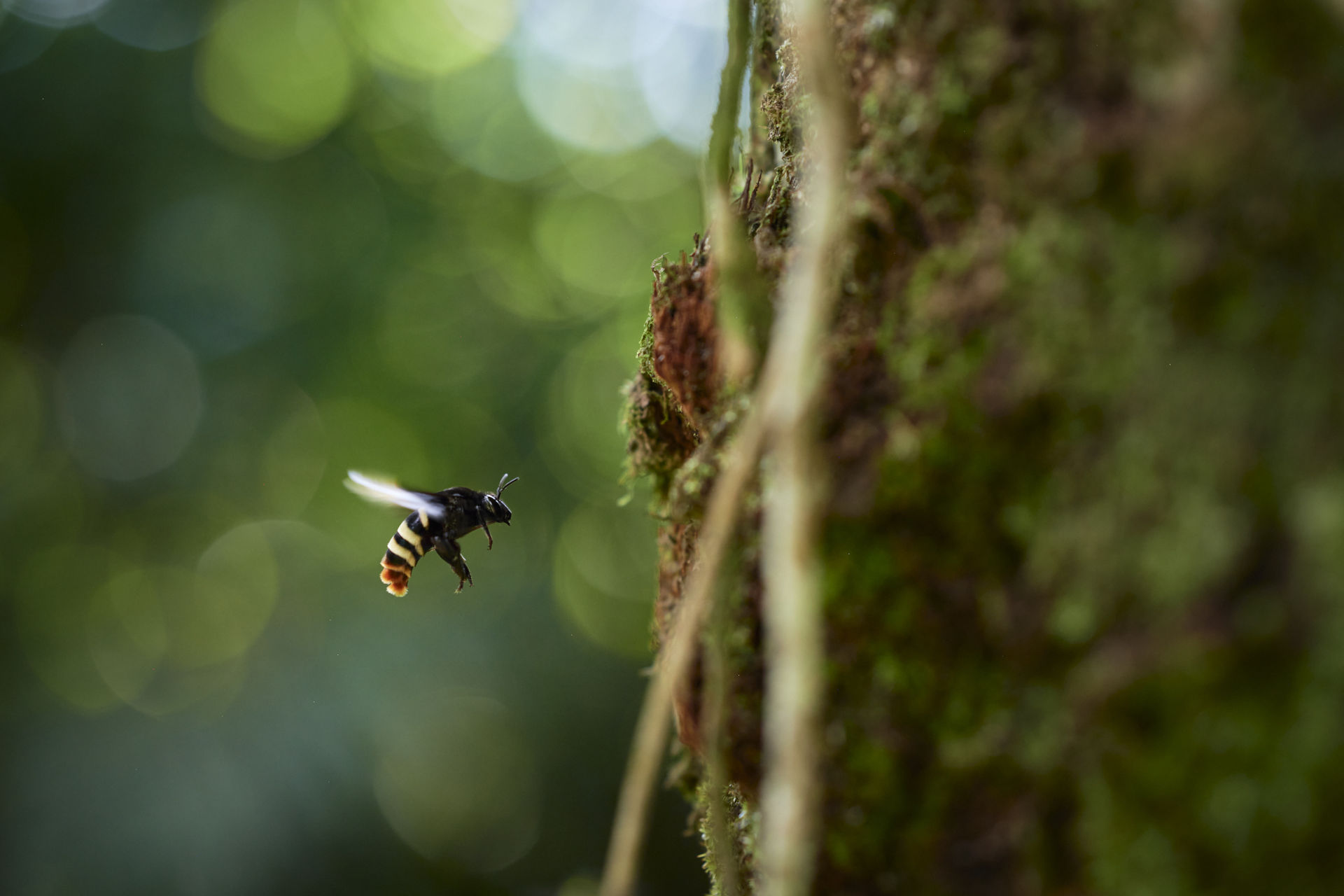
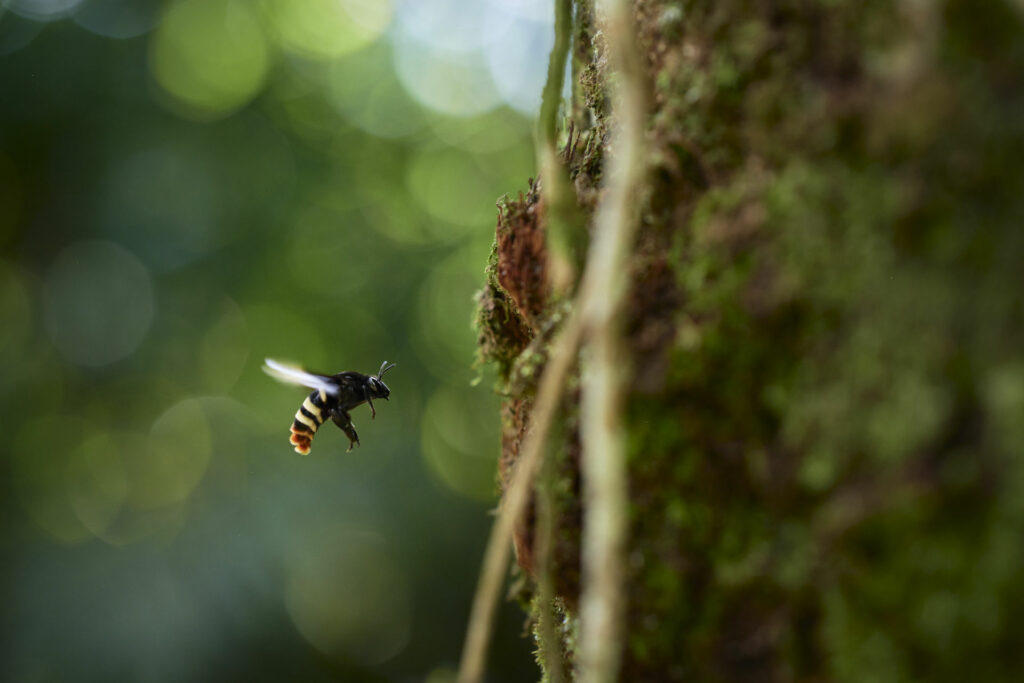
Eulaema meriana—or as I call him, “Thumper”—gathers scent from moss covering an old growth tree in the Costa Rican rainforest.
Scent as embodied ecology
If I could distill everything I’ve learned over the past six years of conducting this research down to one lesson, it’s that our relationship with bees is never just about us and bees. Rather, these interactions provide an intimate and sobering glimpse into humanity’s ethical and ecological responsibilities to all life.
Scent reminds us that relationships are inherently and inescapably mutual. On both a molecular and metaphysical level, olfaction softens the hard edges with which we seek to define our individuality. It shows us that we actively participate in ever-evolving ecological kinships, regardless of whether we realize it. The olfactory impulses we share with orchid bees offers an opportunity to not only recognize, but honor how integral and inextricably rooted we are in nature.
About the Author
Beyond his role as the Contributing Editor of Ecological Thinking at Plantings, Jake Eshelman is a photo-based artist and visual researcher exploring the complex relationships between people and other-than-human beings. Working to transcend the notion that humanity is somehow separate from—or superior to—the natural world. You can learn more about his work, writings, and publications online and via Instagram.
Also, if you are in the New York City area, Jake Eshelman’s investigation of the aromatic phenomena of orchid bee perfume can be seen and smelled in the exhibitionBLENDS: Explorations of Memory, Identity, Intimacy, Ecology, and Danger, curated by Gayil Nalls, at Olfactory Art Keller, 25 Henry Street, New York, NY 10002, March 23 – April 29, 2023, Opening Reception: Thursday, March 23rd at 5:00-7:00.
Sources
1 Ransome, Hilda A., The Sacred Bee in Ancient Times and Folklore, (Mineola, New York, Dover Publications Inc., 2004), p. 218
2 Wario F, Wild B, Rojas R, Landgraf T. Automatic detection and decoding of honey bee waggle dances. PLoS One. 2017 Dec 13;12(12):e0188626. doi: 10.1371/journal.pone.0188626. PMID: 29236712; PMCID: PMC5728493.
3 Whitten WM, Young AM, Stern DL. Nonfloral sources of chemicals that attract male euglossine bees (Apidae: Euglossini). J Chem Ecol. 1993 Dec;19(12):3017-27. doi: 10.1007/BF00980599. PMID: 24248792.
4 Masuo Y, Satou T, Takemoto H, Koike K. Smell and Stress Response in the Brain: Review of the Connection between Chemistry and Neuropharmacology. Molecules. 2021 Apr 28;26(9):2571. doi: 10.3390/molecules26092571. PMID: 33924992; PMCID: PMC8124235.
5 Spence C. The scent of attraction and the smell of success: crossmodal influences on person perception. Cogn Res Princ Implic. 2021 Jun 26;6(1):46. doi: 10.1186/s41235-021-00311-3. PMID: 34173932; PMCID: PMC8233629.
6 “Emotion and Scent.” The Science Teacher, vol. 75, no. 9, 2008, pp. 18–18. JSTOR, http://www.jstor.org/stable/24144158.

As Ireland transitions from the rich, smoky scent of peat-burning to a more sustainable future, its olfactory heritage is evolving. What will become the next iconic aromatic symbol of Ireland?
Click to watch the documentary trailer.



